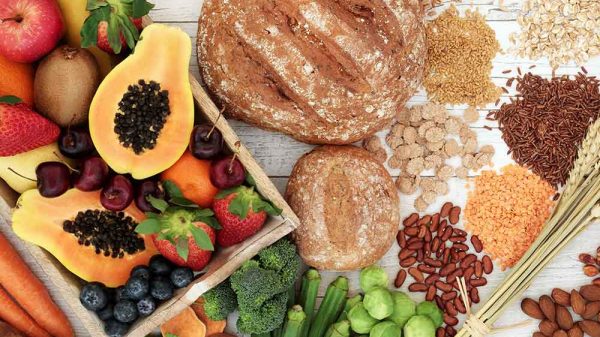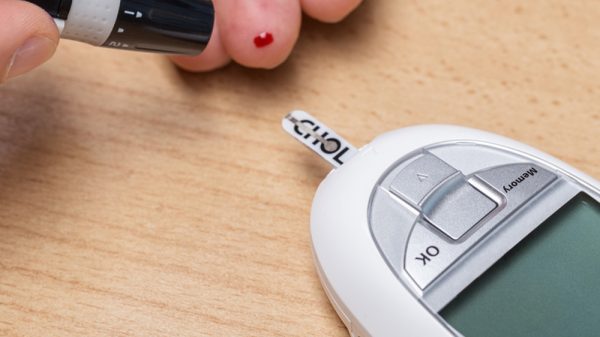Insulin is a hormone in the body that we can’t live without. Any time we eat, especially when we eat meals high in sugar, insulin is hard at work. But what happens when the body produces too much insulin? In this article, we go through everything you need to know about high insulin levels.
Read on to find out what it means to have too much insulin and steps you can take to manage it.
What Is the Role of Insulin in the Body?
To fully understand what it means to have high insulin, it’s helpful to first talk about what insulin does in the body.
Insulin is a hormone created in beta cells of the pancreas. It is then secreted in response to sugar in the bloodstream. When sugar levels in the bloodstream are elevated – such as after a meal – the pancreas releases insulin, which communicates to cells and tissues to utilize glucose for energy.
Our blood sugar levels naturally rise after we eat, since food provides us with energy. In particular, carbohydrates contribute significantly to sugar levels and energy levels. When we eat carbohydrates, the body breaks down large carbohydrate molecules into glucose, which the body can then use for energy.
Glucagon is another hormone that works together with insulin to regulate blood sugar. While insulin is responsible for reducing blood sugar levels, glucagon is responsible for triggering the breakdown of stored sugar in the body into glucose. For example, the body breaks down glycogen in the liver into sugar to be used as energy. The body depends on the function and careful balance of glucagon and insulin to maintain normal blood sugar levels.
What Causes High Insulin Levels?
High insulin levels are commonly caused by insulin resistance. Genetic factors combined with a diet that’s chronically high in sugar can cause the body to stop responding properly to the presence of insulin. Lack of exercise, being overweight, and chronic stress may also contribute to high insulin and insulin resistance. Because the body isn’t responding to insulin and utilizing blood glucose for energy, blood sugar levels skyrocket. In an attempt to manage blood sugar levels, the pancreas continues to produce more and more insulin.
Other Causes of High Insulin Levels
High insulin levels may also result from other causes.
- Insulinoma: More rarely, hyperinsulinemia may also result from nondiabetic causes, such as the growth of an insulinoma. An insulinoma is a tumor that develops on the pancreas and causes the secretion of too much insulin. An insulinoma is diagnosed by your doctor and can be surgically removed. In most cases, insulinomas are not cancerous.
- Insulin overdose: Individuals with type 1 diabetes don’t produce enough insulin. As a result, they must take an insulin injection so that their body knows to use glucose to power the body’s cells. Taking too much insulin can cause the body to absorb too much sugar from the bloodstream. An individual with type 1 diabetes may accidentally administer too much insulin if they take too many doses in one day or use too much insulin in one dose.
High levels of insulin due to an insulinoma or an insulin overdose often result in hypoglycemia. An individual who is hypoglycemic has blood sugar levels that are too low, and the body needs the right amount of glucose in the bloodstream to function optimally. Side effects of too much insulin and symptoms of hypoglycemia include:
- Shakiness
- Fast heartbeat or palpitations
- Sweating
- Anxiety
- Hunger
- Lightheadedness
- Dizziness
- Confusion
How to Manage Hypoglycemia
If you are having a hypoglycemia attack, you can quickly treat it by eating food with sugar that your body can quickly convert into glucose. Fast-acting sugars are the key to treating low blood sugar levels. Avoid foods with protein, since protein slows down digestion and prevents the rapid release of sugar into the bloodstream. Foods to reach for when you are hypoglycemic include:
- Juice
- Glucose tablets
- Honey
- Candy
- Soda
It’s important to check your blood glucose levels about 15 minutes after you consume a high-sugar snack. If your blood glucose levels don’t return to normal, it’s critical to seek medical attention.
Hyperinsulinemia Diet for Managing High Insulin and Insulin Resistance
If you have high insulin levels, insulin resistance, and other indicators of metabolic syndrome, here are a few tips for helping your body regulate blood sugar levels more effectively.
1. Eat Regularly Throughout the Day
Eating frequently helps your blood sugar levels remain stable throughout the day. Aim to eat a healthy snack every few hours, to keep your blood sugar and energy levels stable. When we go for too long without eating, blood sugar levels may dip too low and cause extreme hunger or even hypoglycemia. The result can be binge eating and cravings, making it more likely that you’ll eat too much or reach for sweet snacks that spike your blood sugar.
When you are fasting, the body uses basal insulin to help keep blood sugar levels stable. If you have high insulin, insulin resistance, and type 2 diabetes, it’s a good idea to talk to your health care provider about the safest way to do intermittent fasting.
2. Avoid Junk Foods and Stick to Healthy Snacks
Sticking to healthy snacks and avoiding junk food snacks is crucial for maintaining stable blood sugar levels. Junk foods are any foods that are packed with added sugars, refined grains, and preservatives while lacking vitamins, minerals, protein, and fiber. Steer clear of foods like candy, pastries, cookies, ice cream, and soda.
3. Get Plenty of Protein
Protein takes a long time for the body to break down, which helps slow down digestion and prevent sugar from rapidly entering the bloodstream. Including protein with every snack and meal helps you stay satiated. This monitors your calorie intake, preventing you from overeating or giving into cravings for sweets and junk foods.
Moreover, protein offers amino acids that are vital for the production of muscle tissue, hormones, neurotransmitters, and enzymes. Getting balanced ratios of essential amino acids is particularly vital for healthy immune system function and metabolic function. Lean meats, low-fat dairy, and fatty fish offer ideal ratios of essential amino acids. Chicken breast, turkey breast, salmon, and nonfat Greek yogurt are excellent sources of protein and essential amino acids.
4. Eat Lots of Dietary Fiber
Getting dietary fiber in your diet is crucial for stabilizing blood sugar levels. There are two types of dietary fiber: soluble and insoluble fiber. Soluble fiber is particularly effective for regulating blood sugar. When we ingest soluble fiber, it dissolves and creates a barrier in the digestive tract that slows down and blocks the absorption of sugar into the bloodstream.
For example, when we eat an apple, the body breaks down the apple and slowly releases glucose into the bloodstream, helping to maintain stable blood sugar levels. On the other hand, juice made from apples has undergone an industrial process to remove the fiber and pulp. As a result, apple juice quickly increases blood sugar levels. Therefore, it’s important to avoid fruit juices and opt for whole fruits instead.
5. Choose Whole Grains Instead of Refined Grains
Whole grains are often referred to as complex carbohydrates and are a healthy choice when managing blood sugar levels and high insulin. Whole grains are packed with protein and dietary fiber, helping your body digest the carbohydrates slowly and preventing high blood glucose levels. Excellent choices of whole grains include quinoa, millet, brown rice, whole grain bread, and whole-grain pasta.
Refined grains, on the other hand, are also referred to as simple carbs and are broken down rapidly. Refined grains have been processed to remove fiber, protein, and other nutrients. Without fiber, refined grains are quickly broken down into glucose that is rapidly absorbed into the bloodstream. Because they lack protein, refined grains are quickly digested, leading to a sugar crash. Plus, eating refined grains leaves you hungry again within an hour. Avoid refined grains like white rice, white pasta, and white bread.
6. Exercise Regularly
Engaging in regular strength training and cardio helps improve cardiovascular function and metabolic function. Putting on more lean muscle tissue increases resting metabolic rate and makes the body more efficient in utilizing calories and glucose.
7. Lose Weight
Weight loss is a crucial step towards metabolic health and balanced insulin levels. Carrying excess weight is also associated with higher levels of systemic inflammation, which can worsen insulin resistance, diabetes, PCOS, and fatty liver disease.
If you are overweight, strive to lose weight at a healthy rate and avoid crash diets. Monitoring your calorie intake, exercising, and eating an anti-inflammatory diet can help you lose weight gradually and in a healthy way.
Healthy Snacks and Meals for High Insulin and Insulin Resistance
Here are a few snack and meal ideas when you are supporting healthy insulin levels and metabolic function.
- Greek yogurt with berries: Greek yogurt with fruit is a perfect breakfast or snack. Greek yogurt is packed with protein and essential amino acids, while berries provide antioxidants, fiber, and complex carbohydrates.
- Celery and peanut butter: Celery and peanut butter make a convenient and tasty snack when you’re on the go. Peanut butter offers protein and healthy fats, while celery offers fiber and antioxidants.
- Trail mix: Trail mix is an easy snack that can help quell your hunger between meals. Mix almonds, walnuts, and pecans in a bag with low-sugar dark chocolate chips and pitted dates.
- Protein shake: Looking for an easy, healthy breakfast to enjoy on busy mornings? Prepare a smoothie using frozen bananas, strawberries, almond milk, ground flaxseeds or chia seeds, and an essential amino acid supplement.
- Salmon and roasted veggies: Salmon and veggies make a tasty and nutritious meal any time of the day. Salmon provides anti-inflammatory omega-3 fatty acids and essential amino acids, while veggies offer antioxidants, vitamins, and fiber.
- Veggie and bean salad: Salad is an easy, nutrient-packed lunch or dinner. Chop up your favorite vegetables into bite-size pieces. Great options include tomatoes, cucumbers, onions, broccoli, and kale. Toss with white beans, sun-dried tomatoes, and fresh basil and parsley, lemon juice, olive oil, salt, and pepper.
- Lentil stew: Lentils are packed with fiber, protein, and micronutrients. Lentil stew can be easily prepared ahead of time for lunches or dinners all week. Combine lentils, canned tomatoes, spinach, chopped leeks, carrots, diced sweet potato, garlic, cumin, oregano, salt, and pepper in a pot. Cook until the vegetables are tender and serve over quinoa.
- Baked chicken and quinoa: Chicken is low-fat meat that offers balanced ratios of essential amino acids. Marinate chicken with olive oil, lemon juice, salt, pepper, sage, oregano, and garlic, and bake until cooked through. Serve with roasted asparagus, tomatoes, onions, and quinoa.
Conditions Associated with High Insulin
High insulin may occur in isolation. In many cases, it is combined with other health conditions.
Most commonly, high insulin levels signify the presence of insulin resistance and type 2 diabetes. Insulin resistance over a long period of time may cause type 2 diabetes, or diabetes mellitus. Individuals with type 2 diabetes either have too much insulin that the body isn’t responding to, or the body produces too little insulin. Type 1 diabetes is sometimes associated with high insulin, though this is less common.
Hyperinsulinemia and insulin resistance are also connected to other indicators of metabolic dysfunction. Many individuals with high insulin and insulin resistance also suffer from conditions like fatty liver disease, high blood pressure, high cholesterol, obesity, high blood glucose levels, and systemic inflammation.
Individuals with high insulin may also have polycystic ovary syndrome (PCOS). PCOS is a hormonal condition that affects women and causes symptoms like irregular periods, excess hair growth, and infertility. High testosterone levels, high insulin levels, and insulin resistance are indicators of PCOS.
What Are the Signs and Symptoms of High Insulin?
High insulin and insulin resistance may not have any symptoms initially, though there may be signs that your metabolism isn’t working as it should. Over time, high insulin and insulin resistance can lead to type 2 diabetes, which exhibits several symptoms.
Here are a few signs associated with high insulin levels and insulin resistance:
- High fasting blood sugar levels
- Accumulation of abdominal fat
- High blood triglyceride levels
- High blood pressure
If you have hyperinsulinemia and type 2 diabetes, you may experience:
- Increased hunger and thirst
- Fatigue
- Vision problems
- Wounds that heal slowly
- Infections that occur frequently or are slow to clear
- Increased urination
Conclusion: What Happens When You Have Too Much Insulin and How to Manage It
Insulin is a vital hormone in the body that helps us use sugar for energy. There are a few circumstances that may lead to high levels of insulin. When the body has too much insulin, this may be a sign that cells are not responding normally to the presence of insulin, indicating insulin resistance and metabolic dysfunction. Eating an anti-inflammatory diet with lots of protein, fiber, and fresh fruits and vegetables can help keep blood sugar levels steady and improve metabolic functioning. Alternatively, if you are taking insulin to treat type 1 diabetes, you may accidentally take too much insulin, which leads to hypoglycemia, or low blood sugar. To treat an episode of hypoglycemia, eat a portion of high-sugar food like soda, candy, or fruit juice. Always seeks medical advice about the best way to manage your specific case of insulin resistance, diabetes, or hypoglycemia.























